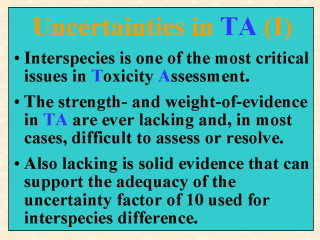 |
The
uncertainties with animal-to-human extrapolation is perhaps one of the most, if not the
most, concerning issues in toxicity assessment. Contrary to general brief, when an adverse
effect is seen in an animal study, the first thing that would come to the risk assessor's
mind is not always questioning whether the same could occur in humans. The first thing
that comes to their mind is likely whether the same could occur in other strains of the
same test species or in another animal species. This is because the strength- and
weight-of-evidence would increase if the same effect could be reproduced in another strain
or another animal species. Rats are commonly used as a test model partly because they are
relatively inexpensive and inbred to reduce variability (Ross et al., 2000).
However, as discussed in Lecture 6, certain drugs such
as the notorious teratogen thalidomide is very species- as well as time-specific. To
date, regulatory agencies still use an uncertainty factor (UF) of 10 for interspecies
extrapolation, thinking that humans can be up to 10 times more susceptible than the test
species used. There is no solid evidence to justify the adequacy of this UF of 10,
however, other than perhaps the account by Dourson and Stara (1983). Before such an
uncertainty can be truly quantified, the equivalence of animal to human dose must first be
examined and resolved. More bluntly, does 1 unit of dose given to a test animal for a
fixed time period actually equal to 1 unit of dose received by a human subject, even after
normalization for body weight? Is it not possible that the rat could detoxify or
bioactivate the same amount of the chemical much faster than a human subject would? |
